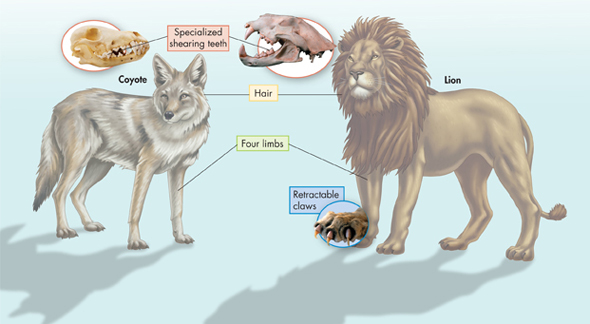Derived Characters In contrast to Linnaean taxonomy, cladistic analysis focuses on certain kinds of characters, called derived characters, when assigning organisms into clades. A derived character is a trait that arose in the most recent common ancestor of a particular lineage and was passed along to its descendants.
Whether or not a character is derived depends on the level at which you're grouping organisms. Here's what we mean. Figure 18–8 shows several traits that are shared by coyotes and lions, both members of the clade Carnivora. Four limbs is a derived character for the entire clade Tetrapoda because the common ancestor of all tetrapods had four limbs, and this trait was passed to its descendants. Hair is a derived character for the clade Mammalia. But for mammals, four limbs is not a derived character—if it were, only mammals would have that trait. Nor is four limbs or hair a derived character for clade Carnivora. Specialized shearing teeth, however, is. What about retractable claws? This trait is found in lions but not in coyotes. Thus, retractable claws is a derived character for the clade Felidae—also known as cats.
Losing Traits Notice above that four limbs is a derived character for clade Tetrapoda. But what about snakes? Snakes are definitely reptiles, which are tetrapods. But snakes certainly don't have four limbs! The ancestors of snakes, however, did have four limbs. Somewhere in the lineage leading to modern snakes, that trait was lost. Because distantly related groups of organisms can sometimes lose the same character, systematists are cautious about using the absence of a trait as a character in their analyses. After all, whales don't have four limbs either, but snakes are certainly more closely related to other reptiles than they are to whales.

FIGURE 18–8 Derived Characters The coyote and lion share several characters—hair, four limbs, and specialized shearing teeth. These shared characters put them in the clades Tetrapoda, Mammalia, and Carnivora. The lion, however, has retractable claws. Retractable claws is the derived character for the clade Felidae.
dTable of Contents
- Formulas and Equations
- Applying Formulas and Equations
- Mean, Median, and Mode
- Estimation
- Using Measurements in Calculations
- Effects of Measurement Errors
- Accuracy
- Precision
- Comparing Accuracy and Precision
- Significant Figures
- Calculating With Significant Figures
- Scientific Notation
- Calculating With Scientific Notation
- Dimensional Analysis
- Applying Dimensional Analysis




